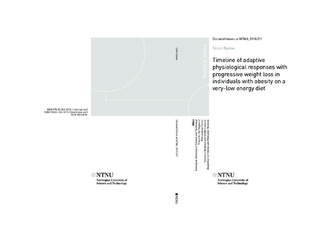| dc.contributor.advisor | Martins, Catia | |
| dc.contributor.advisor | Kulseng, Bård | |
| dc.contributor.author | Nymo, Siren | |
| dc.date.accessioned | 2018-09-26T11:38:50Z | |
| dc.date.available | 2018-09-26T11:38:50Z | |
| dc.date.issued | 2018 | |
| dc.identifier.isbn | 978-82-326-3213-8 | |
| dc.identifier.issn | 1503-8181 | |
| dc.identifier.uri | http://hdl.handle.net/11250/2564694 | |
| dc.description.abstract | Relapse after weight loss remains the biggest challenge in obesity management, likely due to a combination of reduced compliance with diets and exercise regimes and adaptive physiological responses to weight loss. Despite reduced total energy expenditure, the drive to eat is known to increase after weight loss. However, when weight loss is induced with ketogenic diets the expected increase in appetite seems to be absent.
The aim of this PhD thesis was to identify the timeline of changes in both appetite and energy expenditure variables with progressive weight loss in individuals with obesity on a ketogenic very-low energy diet (VLED).
One hundred adult (43±10 years of age) participants (45 males) with obesity (BMI: 37±4 kg/m2) underwent 8 weeks of a ketogenic VLED, followed by 4 weeks refeeding and 1 -year weight maintenance program. Body weight and composition, resting metabolic rate (RMR), exercise induced energy expenditure (EIEE) and appetite (subjective appetite feelings and plasma concentration of appetite hormones: active ghrelin (AG), glucagon-like peptide 1 (GLP-1), peptide YY (PYY) and cholecystokinin (CCK)) were assessed at baseline and week 13, and 1-year (Study III). In a sub-study (31 participants) the same variables were additionally collected at day-3, 5 and 10 % weight loss and week 9 (Studies I and II).
In study I: Hunger and desire to eat feelings in fasting were increased at day-3 and 5 % weight loss despite ketosis and no changes in basal AG plasma concentration (compared with baseline). After refeeding and with a 17 % weight loss, both fasting hunger and AG plasma concentration were increased compared with baseline.
In study II: RMR was reduced for the first time at 5 % weight loss, and EIEE at all levels of power (10, 25 and 50 Watt (W)) reduced at 10 % weight loss, followed by stabilisation. Adaptive thermogenesis was only seen transiently at 10 % weight loss. Refeeding had no significant impact on the above variables.
In study III: A 16 % WL outside of ketosis was associated with an increase in fasting and postprandial hunger ratings and postprandial fullness. These were accompanied by a significant rise in basal and postprandial AG concentrations and a reduction in postprandial CCK. At 1-year follow-up, with sustained WL, fasting hunger and postprandial fullness ratings remained increased. Basal and postprandial AG remained elevated, while postprandial CCK was increased and PYY decreased.
In conclusion, an increased drive to eat should be expected up to 3 weeks (5 % weight loss) on a ketogenic VLED, but thereafter, appetite feelings return to baseline levels for as long as participants are ketotic. A fall in RMR should be anticipated at ≥ 5 % weight loss and a reduction in EIEE at >10 % weight loss. With refeeding, the drive to eat increases and this is sustained up to 1-year follow-up with weight loss maintenance, but it may be balanced out by increased fullness after a meal.
Patients with obesity, and health professionals working with this patient group, should be aware of these findings. This should be discussed against patient’s expectations and strategies need to be put in place to support those undergoing weight loss during the critical periods. | nb_NO |
| dc.language.iso | eng | nb_NO |
| dc.publisher | NTNU | nb_NO |
| dc.relation.ispartofseries | Doctoral theses at NTNU;2018:211 | |
| dc.relation.haspart | Paper 1:
Nymo, Siren; Coutinho, Silvia dos Santos Ribeiro F; Jørgensen, Jeanette; Rehfeld, JF; Truby, H; Kulseng, Bård Eirik; Martins, Catia.
Timeline of changes in appetite during weight loss with a ketogenic diet. International Journal of Obesity 2017 ;Volum 41. s. 1224-1231
-
This work is licensed under a Creative Commons Attribution 4.0 International License (CC BY 4.0)
https://doi.org/10.1038/ijo.2017.96 | |
| dc.relation.haspart | Paper 2:
Nymo, Siren; Coutinho, Silvia dos Santos Ribeiro F; Torgersen, Linn-Christin H.; Bomo, Ola Jakob; Haugvaldstad, Ingrid; Truby, Helen; Kulseng, Bård Eirik; Martins, Catia.
Timeline of changes in adaptive physiological responses, at the level of energy expenditure, with progressive weight loss. British Journal of Nutrition 2018 ;Volum 120.(2) s. 141-149
-
This is an Open Access article, distributed under the terms of the Creative Commons Attribution licence (CC BY 4.0)
https://doi.org/10.1017/S0007114518000922 | |
| dc.relation.haspart | Paper 3:
Nymo, Siren; Coutinho, Silvia dos Santos Ribeiro F; Vestbostad, I.; Kulseng, Bård Eirik; Martins, Catia; Truby, Helen; Rehfeld, Jens Frederik.
Investigation of the long-term sustainability of changes in appetite after weight loss. International Journal of Obesity 2018
-
Open Access This article is licensed under a Creative Commons Attribution 4.0 International License (CC BY 4.0)
https://doi.org/10.1038/s41366-018-0119-9 | |
| dc.title | Timeline of adaptive physiological responses with progressive weight loss in individuals with obesity on a very-low energy diet | nb_NO |
| dc.type | Doctoral thesis | nb_NO |
| dc.subject.nsi | VDP::Medisinske Fag: 700::Klinisk medisinske fag: 750 | nb_NO |
